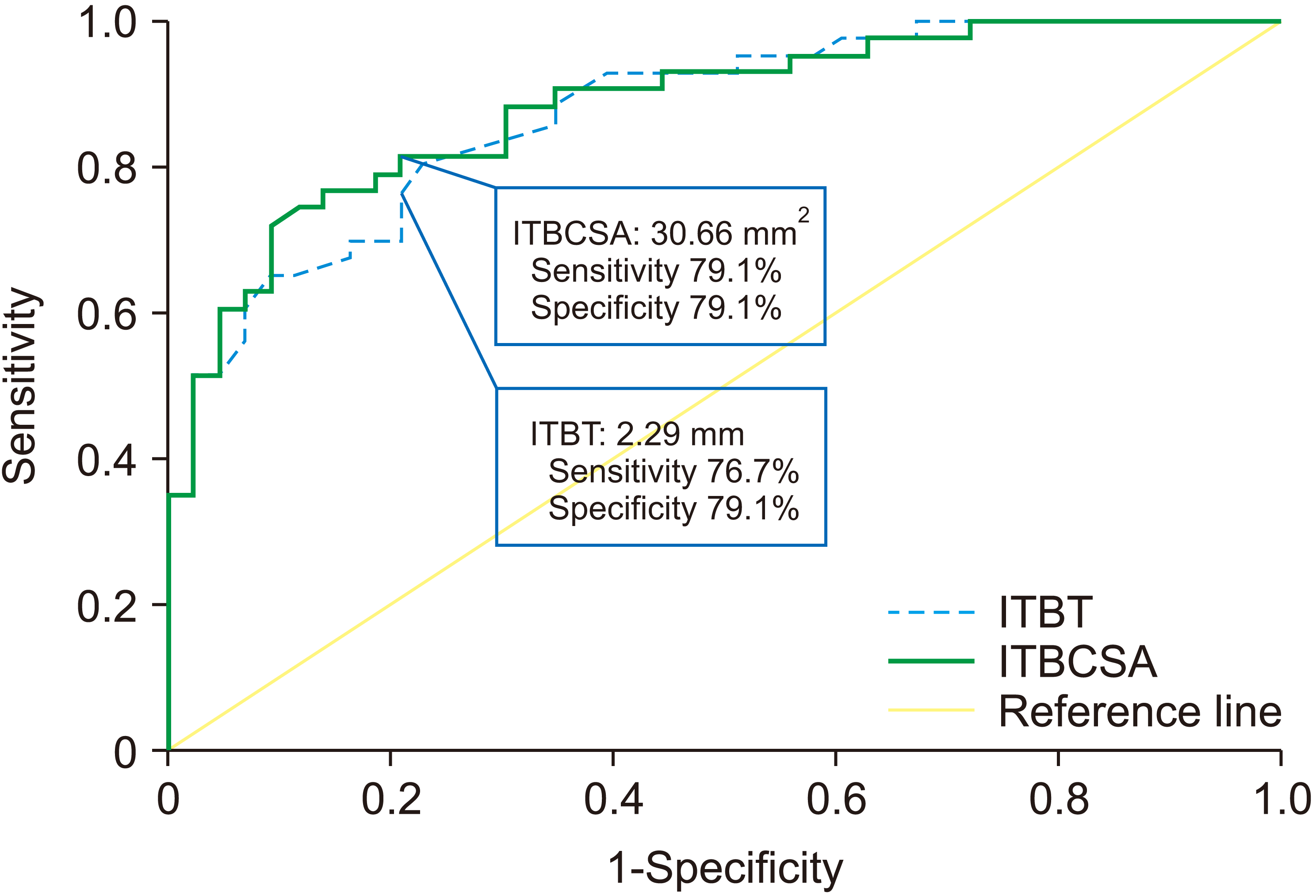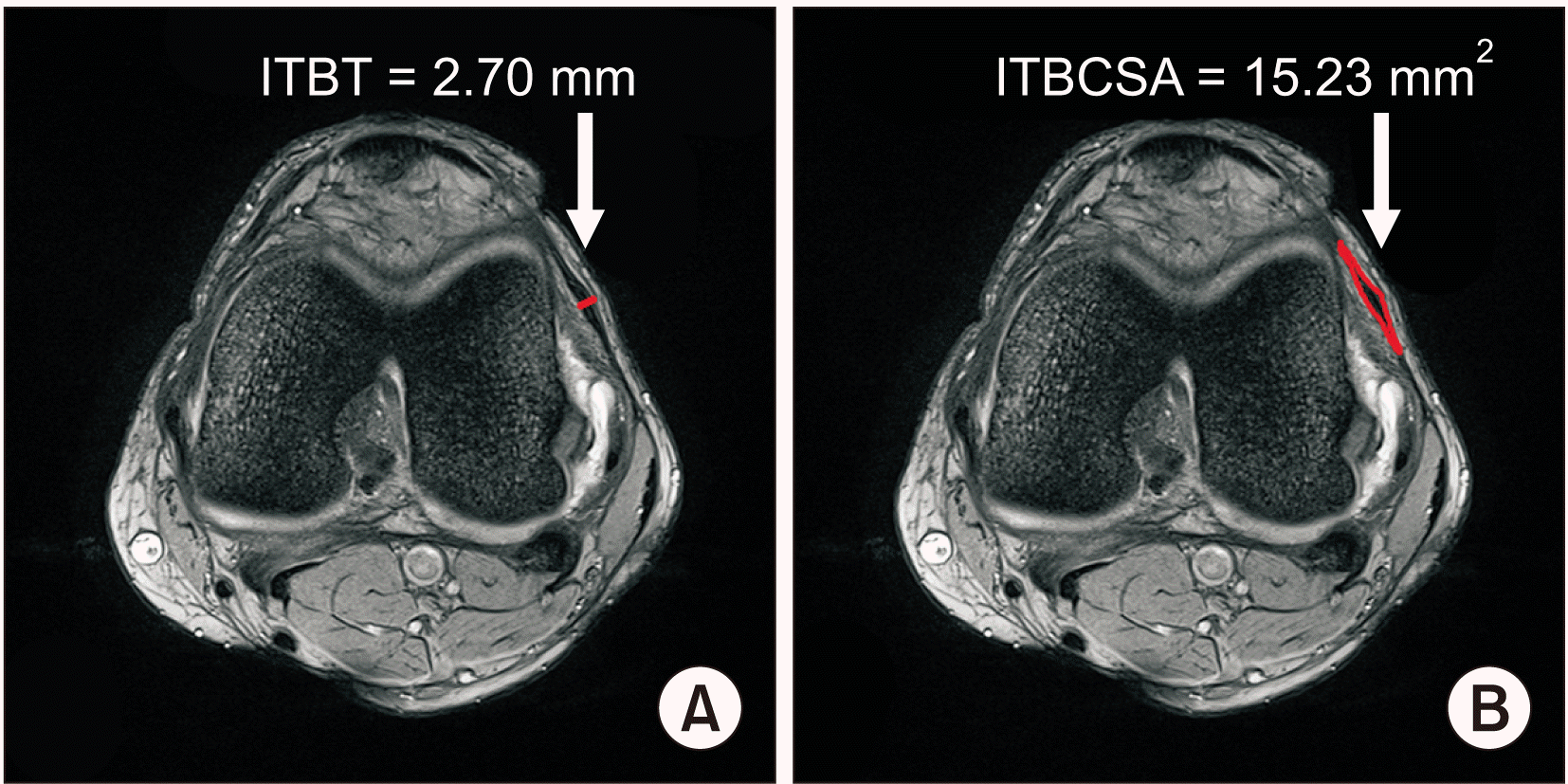1. Flato R, Passanante GJ, Skalski MR, Patel DB, White EA, Matcuk GR Jr. 2017; The iliotibial tract: imaging, anatomy, injuries, and other pathology. Skeletal Radiol. 46:605–22. DOI:
10.1007/s00256-017-2604-y. PMID:
28238018.

5. Lee S, Cho HR, Yoo JS, Kim YU. 2020; The prognostic value of median nerve thickness in diagnosing carpal tunnel syndrome using magnetic resonance imaging: a pilot study. Korean J Pain. 33:54–9. DOI:
10.3344/kjp.2020.33.1.54. PMID:
31888318. PMCID:
PMC6944367.

6. Yan R, Huang Z, Wang L, Zhang X. 2014; [MR manifestations and clinical significance of iliotibial band friction syndrome]. Zhonghua Yi Xue Za Zhi. 94:1473–5. Chinese. PMID:
25143167.
7. Khaund R, Flynn SH. 2005; Iliotibial band syndrome: a common source of knee pain. Am Fam Physician. 71:1545–50. PMID:
15864895.
9. Rathore S, Quadri V, Tapadia S, Krishnaiah K, Krishna VPN. 2017; Intra-articular fibroma of tendon sheath in knee joint associated with iliotibial band friction syndrome: rare occurrence in a teenage girl. J Orthop Case Rep. 7:28–31. DOI:
10.13107/jocr.2250-0685.674. PMID:
28630835. PMCID:
PMC5458692.
10. Takagi K, Inui H, Taketomi S, Yamagami R, Kono K, Nakazato K, et al. 2020; Iliotibial band friction syndrome after knee arthroplasty. Knee. 27:263–73. DOI:
10.1016/j.knee.2019.09.004. PMID:
31883856.

11. Walbron P, Jacquot A, Geoffroy JM, Sirveaux F, Molé D. 2018; Iliotibial band friction syndrome: an original technique of digastric release of the iliotibial band from Gerdy's tubercle. Orthop Traumatol Surg Res. 104:1209–13. DOI:
10.1016/j.otsr.2018.08.013. PMID:
30341031.

13. Everhart JS, Kirven JC, Higgins J, Hair A, Chaudhari AAMW, Flanigan DC. 2019; The relationship between lateral epicondyle morphology and iliotibial band friction syndrome: a matched case-control study. Knee. 26:1198–203. DOI:
10.1016/j.knee.2019.07.015. PMID:
31439366.

14. Foch E, Milner CE. 2019; Influence of previous iliotibial band syndrome on coordination patterns and coordination variability in female runners. J Appl Biomech. 35:305–11. DOI:
10.1123/jab.2018-0350. PMID:
31141437.

15. Landreau P, Catteeuw A, Hamie F, Saithna A, Sonnery-Cottet B, Smigielski R. 2019; Anatomic study and reanalysis of the nomenclature of the anterolateral complex of the knee focusing on the distal iliotibial band: identification and description of the condylar strap. Orthop J Sports Med. 7:2325967118818064. DOI:
10.1177/2325967118818064. PMID:
30729141. PMCID:
PMC6350136.

17. Everhart JS, Kirven JC, Higgins J, Hair A, Chaudhari AMW, Flanigan DC. 2020; Corrigendum to "The relationship between lateral epicondyle morphology and iliotibial band friction syndrome: A matched case-control study [The Knee 26 (2019) 1198-1203]". Knee. 27:1291. DOI:
10.1016/j.knee.2020.06.002. PMID:
32620349.

18. Joo Y, Cho HR, Kim YU. 2020; Evaluation of the cross-sectional area of acromion process for shoulder impingement syndrome. Korean J Pain. 33:60–5. DOI:
10.3344/kjp.2020.33.1.60. PMID:
31888319. PMCID:
PMC6944366.

19. Gadsden JC, Sata S, Bullock WM, Kumar AH, Grant SA, Dooley JR. 2020; The relative analgesic value of a femoral nerve block versus adductor canal block following total knee arthroplasty: a randomized, controlled, double-blinded study. Korean J Anesthesiol. 73:417–24. DOI:
10.4097/kja.20269. PMID:
32842722. PMCID:
PMC7533174.

20. Ciftci B, Ekinci M, Atalay YO. 2020; Ultrasound guided rhomboid intercostal block provides effective pain control after video-assisted thoracoscopic surgery: a brief report of three cases. Korean J Anesthesiol. doi: 10.4097/kja.20538. DOI:
10.4097/kja.20538. PMCID:
PMC7714626. PMID:
33198430.
21. Abdelbaser I, Mageed NA, El-Emam EM, ALseoudy MM, Elmorsy MM. 2020; Preemptive analgesic efficacy of ultrasound-guided transversalis fascia plane block in children undergoing inguinal herniorrhaphy: a randomized, double-blind, controlled study. Korean J Anesthesiol. doi: 10.4097/kja.20601. DOI:
10.4097/kja.20601. PMID:
33307633.

22. Mudumbai SC, Kim TE, Howard SK, Giori NJ, Woolson S, Ganaway T, et al. 2020; Corrigendum: an ultrasound-guided fascia iliaca catheter technique does not impair ambulatory ability within a clinical pathway for total hip arthroplasty. Korean J Anesthesiol. 73:267. DOI:
10.4097/kjae.2016.69.4.368.e1. PMID:
32506897. PMCID:
PMC7280886.






 PDF
PDF Citation
Citation Print
Print




 XML Download
XML Download